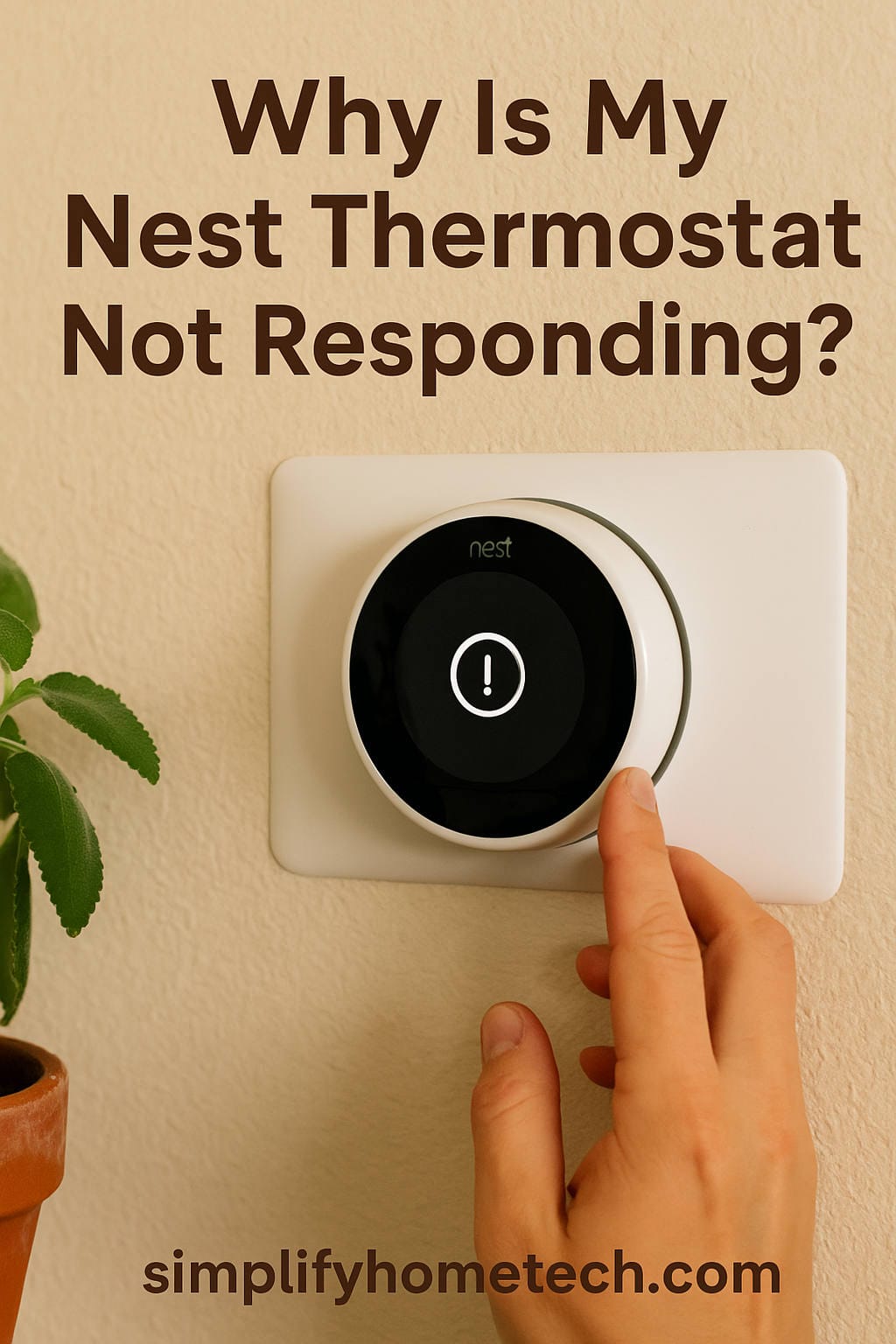Nest thermostats have gained immense popularity in recent years as a key component of smart home systems. These intelligent devices provide seamless control over your home’s heating and cooling, offering convenience and energy efficiency. However, like any technology, Nest thermostats may encounter issues that cause them to stop responding. In this comprehensive troubleshooting guide, we will explore the common reasons behind an unresponsive Nest thermostat and provide step-by-step solutions to get your thermostat back on track.
Check the Basics
Before diving into complex troubleshooting, it’s essential to start with the basics. The first thing to check is whether your Nest thermostat is receiving power and has a stable internet connection. To verify the power source, ensure that your thermostat is properly connected to the electrical system or that the batteries, if applicable, are functioning correctly. If the thermostat is powered through batteries, try replacing them with fresh ones.
Next, confirm that your thermostat is turned on and has a functioning internet connection. An unstable or weak Wi-Fi signal can hinder communication between your thermostat and the Nest servers. Make sure your Wi-Fi router is working correctly, and your thermostat is within a reasonable range from it. If needed, consider using a Wi-Fi range extender to improve signal strength.
Lastly, check for any user errors that may be causing the unresponsiveness. Ensure that the thermostat settings are correctly configured, and the screen is not locked. Sometimes, a simple user oversight can be the root cause of the problem.
Firmware and Software Issues
Firmware and software updates play a crucial role in the smooth operation of Nest thermostats. These updates often contain bug fixes, performance enhancements, and compatibility improvements. An outdated firmware version may lead to unresponsiveness or erratic behavior.
To check for firmware updates, follow these steps:
- Go to the Nest app on your smartphone or tablet.
- Select your thermostat.
- Tap on the settings icon in the top right corner.
- Choose “Software Update.”
- If an update is available, follow the on-screen instructions to install it.
Similarly, software glitches can sometimes occur, causing temporary unresponsiveness. In such cases, performing a restart or reset may resolve the issue. To restart your Nest thermostat, go to the thermostat itself, and press and hold the unit for about ten seconds until it reboots. For a reset, follow these steps:
- Open the Nest app.
- Select your thermostat.
- Tap on the settings icon.
- Choose “Reset.”
- Confirm the reset action.
Keep in mind that a reset will erase all your customized settings and return the thermostat to its default configurations.
Wi-Fi Connectivity Problems
As a smart thermostat, the Nest relies heavily on a stable Wi-Fi connection to communicate with the Nest servers and your smartphone or tablet. A weak or unstable Wi-Fi signal can cause unresponsiveness or delays in executing commands.
To troubleshoot Wi-Fi connectivity issues:
- Move your Wi-Fi router to a central location in your home to improve coverage.
- Ensure that there are no physical obstructions, such as walls or appliances, blocking the Wi-Fi signal.
- Consider upgrading to a higher-quality Wi-Fi router or using a Wi-Fi range extender if your home’s layout necessitates it.
- Check for interference from other electronic devices, such as cordless phones or baby monitors, and adjust their frequencies if needed.
- Restart your Wi-Fi router and your Nest thermostat to establish a fresh connection.
Compatibility and System Requirements
Not all HVAC systems are compatible with Nest thermostats. Before purchasing a Nest thermostat, it’s essential to verify its compatibility with your existing heating and cooling system. The Nest website provides a compatibility checker tool that can help you determine whether your HVAC system will work seamlessly with the Nest thermostat.
If the compatibility check reveals potential conflicts, don’t worry; there are often workarounds to ensure successful integration. For instance, you may need to install an additional common wire (C wire) to provide continuous power to your Nest thermostat. This can prevent power-related issues and improve responsiveness.
If you’re unsure about the compatibility or how to install a C wire, it’s best to consult a professional HVAC technician for assistance.
Sensor and Hardware Troubles
Nest thermostats rely on a range of sensors to provide accurate temperature readings and effectively control your HVAC system. Over time, dust and debris can accumulate on these sensors, impacting their performance and leading to unresponsiveness.
To maintain the sensors and hardware, follow these steps:
- Turn off the thermostat and disconnect it from the power source.
- Gently clean the sensors using a soft cloth or cotton swab, being careful not to scratch or damage them.
- Wipe the thermostat’s exterior to remove any dust or grime.
- Reconnect the thermostat to the power source and turn it back on.
If your thermostat continues to be unresponsive after cleaning the sensors, there may be underlying hardware issues. In such cases, it’s best to seek professional assistance from an HVAC technician experienced in dealing with Nest thermostats.
Battery and Power Source Problems
Nest thermostats can be either hardwired or powered by batteries, and power-related issues can lead to unresponsiveness. If your thermostat is hardwired, check the wiring connections to ensure they are secure and not damaged. For battery-powered thermostats, try replacing the batteries with new ones to rule out battery-related problems.
Additionally, power outages can disrupt the functioning of your thermostat. Although Nest thermostats typically have built-in backup power to retain basic functions during outages, a prolonged outage may affect responsiveness. If you experience frequent power outages, consider installing an uninterruptible power supply (UPS) to ensure continuous operation during power disruptions.
Nest Server Outages and Updates
Nest thermostats rely on cloud servers for certain functionalities, and occasional server outages may cause temporary unresponsiveness. These outages are typically beyond your control and may affect other smart devices in your home that depend on cloud services.
To check if there is a Nest server outage:
- Visit the Nest website or their official social media channels for service status updates.
- If an outage is ongoing, you may need to wait until the issue is resolved on the Nest end.
During server outages, you can still control your thermostat manually at the unit itself, but smart features through the app or voice commands may not work until the servers are back online.
It’s also essential to keep your Nest thermostat updated with the latest software releases. Periodically check for software updates and install them promptly to ensure optimal performance and responsiveness.
Advanced Settings and Configuration
Nest thermostats come with advanced settings that can significantly impact the behavior of your thermostat. While these options offer greater customization, making the wrong changes can lead to unresponsiveness or other issues.
If you’ve made advanced adjustments and your thermostat is not responding as expected, it’s essential to revert to default settings. To reset your Nest thermostat to its factory settings, follow these steps:
- Open the Nest app on your smartphone or tablet.
- Select your thermostat.
- Tap on the settings icon in the top right corner.
- Choose “Reset.”
- Confirm the reset action.
After the reset, reconfigure your thermostat to your preferred settings and observe its performance for any improvements.
Seeking Support from Nest and Professional Help
If you’ve tried all the troubleshooting steps and your Nest thermostat is still unresponsive, it may be time to seek support from Nest’s customer service. The Nest support team can provide specific assistance based on your thermostat’s unique issue. You can reach out to Nest support through their website or app, and they will guide you through additional troubleshooting steps or provide further recommendations.
For complex issues related to your HVAC system or the thermostat itself, it’s best to consult a professional HVAC technician with experience in dealing with Nest products. An HVAC technician can diagnose and resolve more intricate problems and ensure that your thermostat is functioning optimally within your heating and cooling system.
Avoid attempting DIY repairs, especially if your thermostat is under warranty. Unauthorized repairs or modifications may void your warranty, leaving you without recourse if future issues arise.
Conclusion
In conclusion, a responsive Nest thermostat is integral to maintaining a comfortable and energy-efficient home. By following this comprehensive troubleshooting guide, you can identify and resolve common issues that may cause your Nest thermostat to stop responding. Remember always to start with the basics, update firmware and software regularly, ensure a stable Wi-Fi connection, and maintain the sensors and hardware for optimal performance.
In some cases, you may need to address compatibility concerns or seek professional assistance to diagnose and fix underlying problems. However, with persistence and adherence to the troubleshooting steps, you can restore your Nest thermostat to its full functionality.
A well-functioning smart thermostat system provides convenience, energy efficiency, and peace of mind, contributing to a more comfortable and sustainable living environment for you and your family. By addressing these issues proactively, you can maximize the benefits of your Nest thermostat and enjoy the comfort and control it brings to your home.
Featured Photo by Dan LeFebvre on Unsplash
You might also like,
Troubleshooting Nest Thermostat: Common Issues and How to Fix Them

